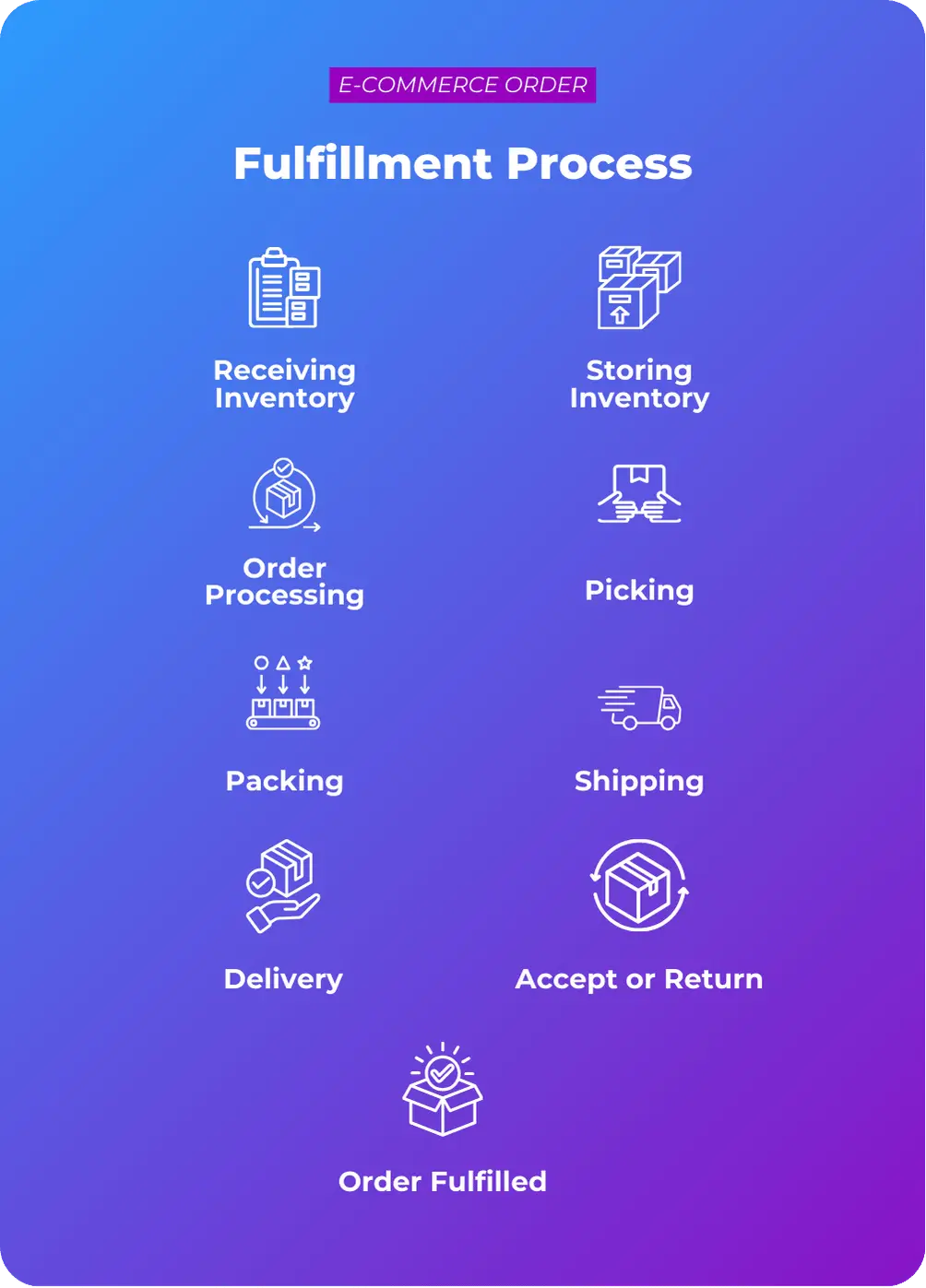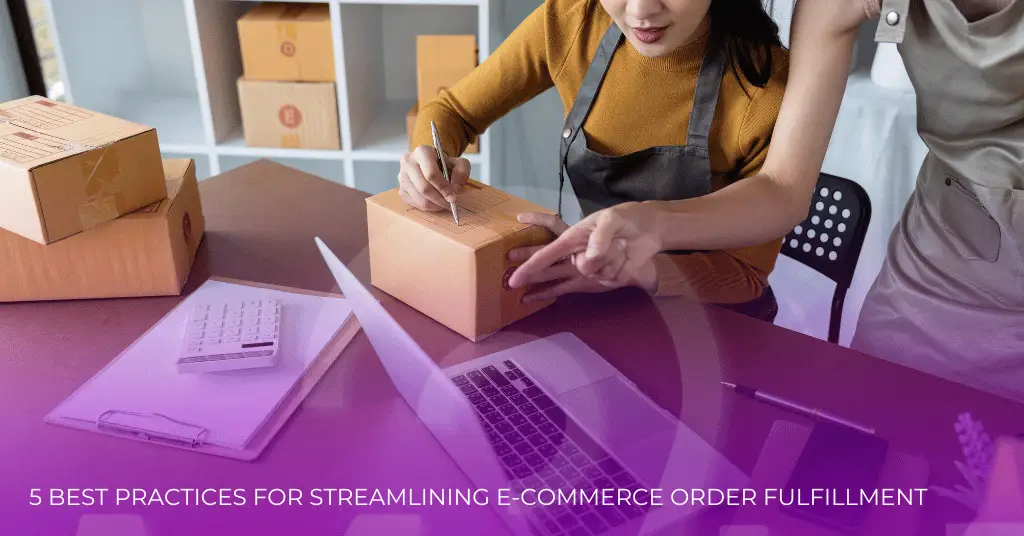تعرف على كيفية مساعدتك لنظام إدارة التسليم الخاص بـ Mile في تبسيط عملية استيفاء طلبات التجارة الإلكترونية الخاصة بك لتحسين الكفاءة ورضا العملاء.
بأبسط العبارات، يشير تنفيذ طلبات التجارة الإلكترونية إلى عملية استلام طلب على قناة مبيعات التجارة الإلكترونية، واختيار العناصر المطلوبة في مستودع أو مركز تنفيذ، وتعبئتها في عبوات تحمل علامة تجارية، وإرسال الطرد بواسطة مزود لوجستي داخلي أو تابع لجهة خارجية (3PL)، وتسليمه إلى العميل. في بعض الأحيان، يشمل أيضًا الإرجاعات واسترداد الأموال والاستبدال.
بالنسبة لتجار التجزئة عبر الإنترنت، فإن الطلب الجديد على قائمة الطلبات ليس سببًا للاحتفال. فالفرحة الحقيقية تبدأ فقط عندما يتلقى العميل الطلب في الوقت الذي يريده وفي الحالة التي يريدها. وذلك لأن هناك فرصة جيدة لأن يتضاعف الطلب الذي تم تنفيذه بنجاح إلى عشرات ومئات الطلبات.
ومن ثم، فمن المهم تنفيذ كل خطوة في عملية تنفيذ طلبات التجارة الإلكترونية بدقة لضمان حصول العملاء على طلباتهم بدقة وفي الوقت المحدد.
7 خطوات لإتمام طلبات التجارة الإلكترونية بنجاح
1. استلام المخزون
تتضمن الخطوة الأولى في عملية تنفيذ الطلب استلام المخزون. يمكن أن تصل البضائع من مصادر متعددة: الموردين الخارجيين، أو الأقسام الداخلية للشركة، أو المستودعات، أو حتى كبيانات رقمية من قواعد البيانات. يمكن أن يختلف الشكل الذي يصل به المخزون على نطاق واسع، بدءًا من المنتجات المادية إلى السوائل التي يتم تسليمها عبر خطوط الأنابيب أو الملفات الرقمية.
عند الوصول، يتم عد المخزون بعناية وفحصه وتسجيله للتأكد من استلام الكميات الصحيحة وأنها تلبي معايير الجودة المطلوبة. يتم استخدام رمز شريطي أو مولد وحدة حفظ المخزون (SKU) يقوم بتعيين رمز أبجدي رقمي فريد لكل منتج من خلال دمج سمات محددة مثل الفئة والعلامة التجارية والحجم واللون، مما يساعد الشركات على تتبع وإدارة المخزون بكفاءة. تُستخدم هذه الرموز الشريطية أو وحدات SKU لتبسيط عملية الاستلام وتسهيل استرجاع العناصر لاحقًا من التخزين.
2. تخزين المخزون
بمجرد استلام المخزون، يتم توزيعه على الفور أو تخزينه للاستخدام في المستقبل. والهدف من تخزين المخزون هو تنظيم المنتجات بطريقة تدعم تنفيذ الطلبات بكفاءة، بدلاً من الاحتفاظ بالمخزون لفترات زمنية طويلة. يتم تصنيف العناصر إلى تخزين قصير الأجل أو طويل الأجل بناءً على الطلب المتوقع. تضمن إدارة التخزين المناسبة إمكانية الوصول بسهولة إلى المنتجات لالتقاطها عند تقديم الطلبات.
لتقييم كفاءة المخزون، يمكن للشركات حساب أيام المخزون في متناول اليد عن طريق قسمة متوسط المخزون على التكلفة اليومية للسلع المباعة (COGS). يكشف هذا الحساب عن متوسط عدد الأيام التي سيستمر فيها المخزون قبل الحاجة إلى تجديده.
3. معالجة الطلبات
تبدأ عملية معالجة الطلبات بمجرد أن يقدم العميل طلبًا. ويقوم نظام إدارة الطلبات، الذي غالبًا ما يكون مدمجًا مع عربة التسوق على موقع التجارة الإلكترونية، بتفعيل عملية التنفيذ تلقائيًا. وينسق هذا النظام أنشطة الالتقاط والتعبئة ويضمن اختيار المنتجات وإعدادها للشحن وفقًا لمواصفات طلب العميل.
4. قطف
تتضمن عملية الاختيار اختيار العناصر الصحيحة من المستودع بناءً على التفاصيل المقدمة في ورقة التعبئة. تتضمن هذه الورقة معلومات بالغة الأهمية مثل وحدات تخزين المواد وألوان المنتجات وأحجامها وكمياتها والموقع المحدد للعناصر داخل المستودع. يمكن إجراء عملية الاختيار بواسطة فريق من العمال أو من خلال استخدام أنظمة آلية، مثل روبوتات المستودعات، والتي يمكن أن تعزز السرعة والدقة.
5. التعبئة والتغليف
بعد اختيار العناصر، يتم الانتقال إلى مرحلة التعبئة والتغليف. وهنا، يكون الهدف هو اختيار مواد التعبئة والتغليف التي من شأنها تقليل الوزن الأبعادي للحزمة. يتم حساب الوزن الأبعادي عن طريق ضرب طول الحزمة وعرضها وارتفاعها. نظرًا لأن تكاليف الشحن تعتمد غالبًا على الوزن الأبعادي، فإن تحسين هذا الجانب من التعبئة والتغليف يمكن أن يساعد في تقليل نفقات الشحن.
قد تتضمن فرق التعبئة والتغليف أيضًا مواد الشحن المرتجعة والملصقات في حالة احتياج العميل إلى إرجاع المنتج أو استبداله. تسهل هذه الخطوة الاستباقية معالجة الإرجاعات بشكل أكثر سلاسة لاحقًا.
6. الشحن
بمجرد تعبئة الطلب، يتم تسليمه إلى شركة شحن. يمكن أن تكون هذه الشركة موردًا داخليًا أو مزودًا لوجستيًا تابعًا لجهة خارجية. تحدد شركة الشحن تكاليف الشحن بناءً على الوزن الفعلي للحزمة أو وزنها الأبعادي، أيهما أكبر. لتجنب التكاليف غير الضرورية، من الضروري تعبئة العناصر بكفاءة للحفاظ على الوزن الأبعادي منخفضًا قدر الإمكان.
غالبًا ما يكون لدى شركات النقل أيضًا متطلبات تغليف محددة يجب الوفاء بها لضمان التسليم في الوقت المناسب وبتكلفة فعّالة. قد يؤدي عدم الامتثال لهذه المتطلبات إلى تأخيرات إذا رفضت شركة النقل قبول الشحنة.
7. التسليم
لم يغير نمو التجارة الإلكترونية طريقة التسوق فحسب، بل غيّر أيضًا الطريقة التي نريد بها توصيل طلباتنا. أدى تفضيل العملاء المتزايد للسرعة والراحة وبأسعار معقولة في تلقي الطلب إلى دفع العديد من بائعي التجارة الإلكترونية إلى إضافة خيارات توصيل متعددة من أجل تلبية توقعات العملاء.
يوفر كل خيار مستوى فريدًا من السرعة والراحة والفعالية من حيث التكلفة لتلبية احتياجات العملاء المختلفة.
- التسليم في نفس اليوم: سيتم تسليم العناصر خلال ساعات من الشراء.
- التسليم في اليوم التالي: وهذا يضمن الوصول في اليوم التالي.
- التسليم في الفترة الزمنية: يتيح هذا للعملاء اختيار فترة تسليم محددة.
- التسليم القياسي: هذا خيار أرخص ولكنه يستغرق من 3 إلى 5 أيام عمل.
- الاستلام من المتجر: يقوم المتسوقون بجمع مشترياتهم مباشرة من المتجر.
- انقر وجمع: هذه العملية مشابهة للاستلام من المتجر، لكن يتم الاستلام من مواقع محددة.
معالجة المرتجعات (اختياري)
على الرغم من كونها اختيارية، فإن معالجة الإرجاعات تشكل جزءًا لا يتجزأ من عملية تنفيذ الطلب. تبدأ بإدراج مواد الشحن المرتجعة والملصق في الشحنة الأصلية للعميل. إذا قرر العميل إرجاع منتج، فإن العملية تتضمن عدة خطوات لتحديد ما إذا كان يمكن إعادة تخزين العنصر. يتم إجراء فحوصات مراقبة الجودة لتقييم حالة المنتج المرتجع. إذا كان في حالة جيدة، فيمكن إعادته إلى المخزون. ومع ذلك، إذا كان المنتج معيبًا أو تالفًا أو متسخًا، فقد يلزم إعادته إلى البائع لاسترداد المبلغ، أو إعادته إلى الشركة المصنعة، أو التخلص منه بشكل مناسب، مثل إعادة التدوير، على سبيل المثال.

كل من هذه الخطوات ضرورية لضمان عملية تنفيذ الطلبات بسلاسة وكفاءة. من خلال إدارة كل مرحلة بشكل فعال، يمكن للشركات تحسين رضا العملاء وخفض التكاليف وتبسيط عملياتها. سواء كنت تتعامل مع منتجات مادية أو سلع رقمية، فإن عملية تنفيذ الطلبات المنفذة بشكل جيد ضرورية لأي شركة تهدف إلى تقديم خدمة عالية الجودة لعملائها.
أفضل 5 ممارسات لتنفيذ طلبات التجارة الإلكترونية
مع تحول التسوق عبر الإنترنت إلى القاعدة الأساسية في حياتنا، أصبح من المهم للغاية بالنسبة لمقدمي الخدمات اللوجستية الخارجية تبسيط سير عملهم لضمان استلام المستهلكين لطلباتهم بسرعة ودقة وكفاءة. فيما يلي، قمنا بإدراج سبع ممارسات من أفضل الممارسات لتلبية طلبات التجارة الإلكترونية لمقدمي الخدمات اللوجستية الخارجية.
التكاملات وسير العمل السلسة
كما ذكرنا أعلاه، يتطلب الأمر سبع خطوات على الأقل لإتمام الطلب بنجاح. وبدلاً من التعامل مع كل خطوة على حدة على أنظمة مختلفة، فمن الأفضل دمج إدارة المستودعات ومعالجة الطلبات وإدارة التسليم والخدمات اللوجستية العكسية على منصة واحدة موحدة لتوحيد عملية إتمام الطلب.
نصيحة احترافية: قم بالتبديل إلى Mile!
يتكامل حل إدارة التسليم الشامل من Mile مع وحدات إدارة المستودعات والمخزون والطلبات بسلاسة مع قنوات مبيعات التجارة الإلكترونية المختلفة لتسهيل تبادل البيانات بشكل أكثر سلاسة وتحسين الكفاءة العامة.
كما يأتي مع وحدة إدارة لوجستية عكسية تساعدك على تتبع وإدارة المنتجات المرتجعة ومعالجتها في المخزون بشكل صحيح. ولكن، قبل كل شيء، يوفر Mile إرجاعات في الوقت الفعلي في الميدان، حيث يسمح للسائقين بوضع علامة على العناصر المرفوضة/المرتجعة في الميدان وتحديث مبلغ الدفع عند التسليم على الفور. يزيل هذا النظام الحاجة إلى رحلة ثانية لجمع المرتجعات، ويقلل من تأخيرات المستودعات، ويضمن عملية إرجاع سلسة وشفافة لكل من السائقين والعملاء.
تقنيات الأتمتة
تعمل أتمتة المستودعات على تعزيز سرعة ودقة عمليات المستودعات بشكل كبير. على سبيل المثال، تعمل أجهزة مسح الباركود المحمولة وأنظمة التقاط الضوء ومحطات التعبئة الآلية على تقليل مخاطر الخطأ البشري بشكل كبير.
كما تعمل الأتمتة على تحقيق نتائج إيجابية في عمليات الإرسال. فعندما تتم أتمتة تعيينات المناطق وتحسين المسارات من خلال خوارزميات الذكاء الاصطناعي والتعلم الآلي المتقدمة، لم يعد يتعين على شركات الخدمات اللوجستية الخارجية قضاء ساعات في تعيين الطلبات والمناطق للسائقين ورسم المسارات المثلى يدويًا. وبالإضافة إلى تقصير دورات التسليم، تساعد هذه التكنولوجيا أيضًا الشركات على توسيع نطاق عملياتها لتلبية متطلبات المستهلكين المتزايدة للتسليم في نفس اليوم.
نصيحة احترافية: قم بالتبديل إلى Mile!
ميلز حلول إدارة التسليم يحتوي هذا التطبيق على ميزات متقدمة لتحسين الخدمات اللوجستية. فهو يتضمن إرسالًا تنبؤيًا مدعومًا بالذكاء الاصطناعي مع محرك قواعد قابل للتكوين وتوزيع الطلبات على مستوى المناطق بواسطة الذكاء الاصطناعي من أجل عمليات تسليم فعّالة. كما يدعم الحل إنشاء ومسح بوليصة الشحن، وتحسين المسار باستخدام السياج الجغرافي، وخرائط الحرارة. بالإضافة إلى ذلك، يتميز بالتعرف على خط اليد بالذكاء الاصطناعي ومسح الكائنات ثلاثية الأبعاد المستند إلى التعلم الآلي لقياس الطرود بدقة.
تتبع المخزون في الوقت الحقيقي
وكما هو مهم بالنسبة لتجار التجزئة التقليديين، فإن رؤية المخزون في الوقت الفعلي أمر ضروري بالنسبة لتجار التجزئة عبر الإنترنت أيضًا للحفاظ على مستويات المخزون الدقيقة، ومنع نفاد المخزون، والحد من الطلبات المؤجلة. يجب أن تتضمن عملية تنفيذ الطلبات القوية نظامًا متكاملًا لتتبع المخزون في الوقت الفعلي يمكن الوصول إليه من أي مكان وفي أي وقت.
نصيحة احترافية: قم بالتبديل إلى Mile!
تمنحك تقنية Mile's رموزًا ورموزًا شريطية فريدة لمخزون المستودع الخاص بك. يتيح لك هذا مسح العناصر المختارة والمعبأة والتحقق منها بدقة كاملة. يضيف مسح الرموز الشريطية طبقة إضافية من مراقبة الجودة ويضمن رؤية المخزون الخاص بك في الوقت الفعلي.
التواصل الفعال مع العملاء
إذا حافظت على تواصل واضح مع عملاء التجارة الإلكترونية، فإن إنجاز الطلبات من خلال جهات خارجية يصبح أسهل كثيرًا. ومن خلال إطلاعهم على مستويات المخزون وحالة الطلب وأي مشكلات محتملة، يمكنك بناء الثقة وتمكينهم من التخطيط بشكل أفضل.
نصيحة احترافية: قم بالتبديل إلى Mile!
يأتي حل الخدمات اللوجستية المتكاملة من مايل مع بوابة تجارية وتطبيق سائق لتسهيل الرؤية الشاملة لعملية التسليم وتبسيط الاتصالات في الوقت الفعلي بين جميع أصحاب المصلحة المشاركين فيها.
الالتزام بالتحسين المستمر
إذا كنت ترغب في البقاء في صدارة المنافسة، فيجب عليك تقييم وتحسين سير عمل تنفيذ الطلبات من وقت لآخر. راجع مقاييس الأداء بانتظام، وحدد مجالات التحسين، ونفذ التغييرات المطلوبة. سيضمن هذا النهج الاستباقي أن تظل أعمالك اللوجستية مرنة وقادرة على الاستجابة للاحتياجات المتطورة للسوق.
نصيحة احترافية: قم بالتبديل إلى Mile!
توفر ميزات التقارير المتقدمة والتحليلات التنبؤية التي يوفرها تطبيق Mile رؤى قيمة حول عمليات تنفيذ الطلبات. وسوف تساعدك هذه الميزات على إدارة أحجام الطلبات المتقلبة واتخاذ قرارات تعتمد على البيانات وتدفع نحو التحسين المستمر.
هل تريد رؤية مايل في العمل؟ جدولة عرض توضيحي اليوم!

